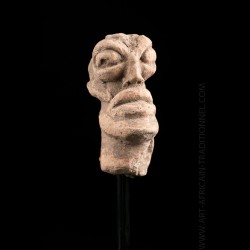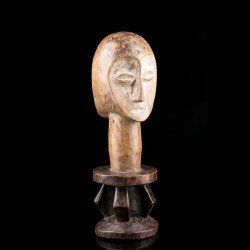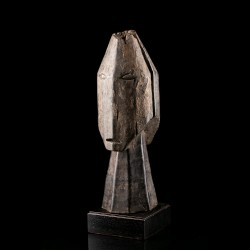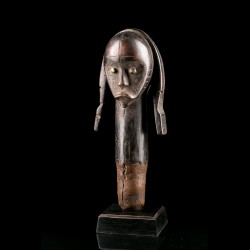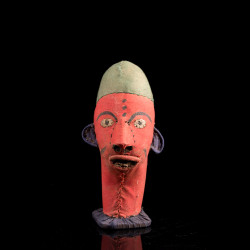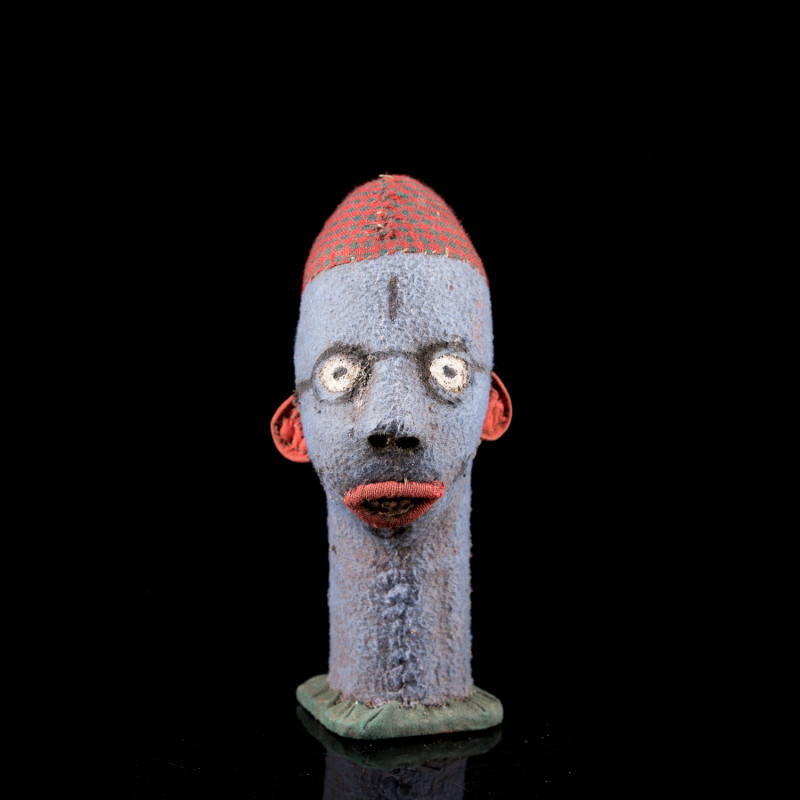










African muzidi head from the Bwende.
The Bembe, a sub-group of the large Kongo ethnic group of DR Congo, use two types of key figures known in African art: ancestral statues used to represent and honor deceased community leaders, and another group of power figures used by diviners to cure ailments.
The Bembe (and their neighbors the Bwende) believe that the reliquary figures of which this one is reduced to the head, covered with textiles, are representations of ancestors.
The spirits of the dead, minkuyu, would reside in these characters. These muzidi figures highlight the continuity between ancestors and living relatives.
They serve as a mechanism for continuous contact between the living and the dead. They also demonstrate the important role the ancestors are believed to play in providing fertility and protection to the family and community.
Prayers are offered to muzidi heads and dolls in the hope that the nkuyu ancestor residing in a figure will reveal what the future holds for the family or communicate the required resolution in a dispute.
Muzidi are usually made before an individual dies. Several months after the death of a revered elder, his body is exhumed and the remains of his body are transferred to the muzidi reliquary receptacle and bound with textiles.
The Swedish missionary, Karl Edvard Laman indicates: "When the muzidi is empty and no nkuyu has entered it, then it is only a kinsisia image.
Once the nkuyu spirit is transferred into the muzidi, the figure is displayed in a funeral celebration to honor the deceased, after which the figure is housed in the family home.
Data sheet
You might also like

African muzidi head from the Bwende.
The Bembe, a sub-group of the large Kongo ethnic group of DR Congo, use two types of key figures known in African art: ancestral statues used to represent and honor deceased community leaders, and another group of power figures used by diviners to cure ailments.
The Bembe (and their neighbors the Bwende) believe that the reliquary figures of which this one is reduced to the head, covered with textiles, are representations of ancestors.
The spirits of the dead, minkuyu, would reside in these characters. These muzidi figures highlight the continuity between ancestors and living relatives.
They serve as a mechanism for continuous contact between the living and the dead. They also demonstrate the important role the ancestors are believed to play in providing fertility and protection to the family and community.
Prayers are offered to muzidi heads and dolls in the hope that the nkuyu ancestor residing in a figure will reveal what the future holds for the family or communicate the required resolution in a dispute.
Muzidi are usually made before an individual dies. Several months after the death of a revered elder, his body is exhumed and the remains of his body are transferred to the muzidi reliquary receptacle and bound with textiles.
The Swedish missionary, Karl Edvard Laman indicates: "When the muzidi is empty and no nkuyu has entered it, then it is only a kinsisia image.
Once the nkuyu spirit is transferred into the muzidi, the figure is displayed in a funeral celebration to honor the deceased, after which the figure is housed in the family home.
